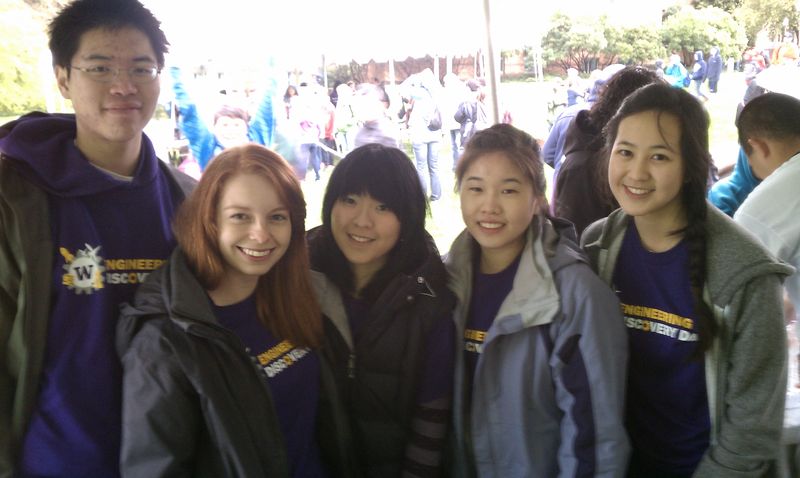Team:Washington/Outreach
From 2012.igem.org
| Line 3: | Line 3: | ||
<h1 id='Outreach'>Outreach</h1> | <h1 id='Outreach'>Outreach</h1> | ||
<p> Every year, the University of Washington invites local K-8 students on campus to learn about science and engineering at a two day long event called Engineering Discovery Days. Our team was invited to teach students about the basics of synthetic biology and biotechnology. Thus on a wet and foggy spring morning, we set up shop alongside the Department of Bioengineering on the lawn of Rainier Vista to teach students about recombinant fluorescent proteins. </p> | <p> Every year, the University of Washington invites local K-8 students on campus to learn about science and engineering at a two day long event called Engineering Discovery Days. Our team was invited to teach students about the basics of synthetic biology and biotechnology. Thus on a wet and foggy spring morning, we set up shop alongside the Department of Bioengineering on the lawn of Rainier Vista to teach students about recombinant fluorescent proteins. </p> | ||
| + | |||
| + | [[Image:FriendlyPicture.jpg|border|300px|right|thumb|A few of us braving the cold spring morning!]] | ||
| + | |||
<br> | <br> | ||
<p>When we were first invited to the event weeks before, we did not have much of an idea of what to do. Some initial ideas were: DNA extraction demonstration, making customizable proteins from pipe cleaners and beads, and modeling transcription with roleplay. After much deliberation, we finally settled on an activity where we taught students how recombinant fluorescent proteins come into existence; starting from a gene encoding the protein to the final fluorescing product. </p> | <p>When we were first invited to the event weeks before, we did not have much of an idea of what to do. Some initial ideas were: DNA extraction demonstration, making customizable proteins from pipe cleaners and beads, and modeling transcription with roleplay. After much deliberation, we finally settled on an activity where we taught students how recombinant fluorescent proteins come into existence; starting from a gene encoding the protein to the final fluorescing product. </p> | ||
| Line 20: | Line 23: | ||
Girl: Then how can you be sure that they don’t have faces? <br> | Girl: Then how can you be sure that they don’t have faces? <br> | ||
Erik: I guess I can’t be sure they don’t have faces. <br> | Erik: I guess I can’t be sure they don’t have faces. <br> | ||
| - | |||
| - | |||
| - | |||
| - | |||
Revision as of 06:21, 29 September 2012
Outreach
Every year, the University of Washington invites local K-8 students on campus to learn about science and engineering at a two day long event called Engineering Discovery Days. Our team was invited to teach students about the basics of synthetic biology and biotechnology. Thus on a wet and foggy spring morning, we set up shop alongside the Department of Bioengineering on the lawn of Rainier Vista to teach students about recombinant fluorescent proteins.
When we were first invited to the event weeks before, we did not have much of an idea of what to do. Some initial ideas were: DNA extraction demonstration, making customizable proteins from pipe cleaners and beads, and modeling transcription with roleplay. After much deliberation, we finally settled on an activity where we taught students how recombinant fluorescent proteins come into existence; starting from a gene encoding the protein to the final fluorescing product.
We chose to model this system with a few props. The first thing we used were small plush toys called “biochemies” (www.biochemies.com) that represent DNA. Biochemies are stuffed toys that resemble the four DNA bases. They have magnets that allow the complementary base pairs to connect but do not allow for mismatching between base pairs. This helped the students learn about Watson-Crick base pairing while we talked about how these DNA bases are able to store information about every organism.
After modeling Watson-Crick base pairing, we illustrated transcription, translation, and protein labeling of DNA into protein in front of a captivated audience. We represented the protein with a long ribbon which we curled up to represent secondary and tertiary protein structure. Once we completed the folding process, we tied a ribbon to a glowstick to represent a complete and functional fluorescently tagged protein. Finally, since this process is normally confined to cells, we put the “fluorescently tagged protein” into a glove, cracked the glow stick, and inflated the glove. We told the students that when they got home that they could “lyse” the glove and extract the fluorescent protein, or continue to enjoy their glowing bacterial cell. In the end, this taught our students about transcription, translation, and protein labeling as well as giving them something cool to take home.
We really enjoyed our experience at Discovery Days, especially when the students asked us great questions like “How does the protein glow.” We were surprised how knowledgeable one of the elementary school students was when he said “The ribosome makes the protein, right?” Later in the day we got famous when students came to our booth asking if “we were the people who made the glove balloons.” Overall, we enjoyed our experience at Discovery Days and we thought this was a great opportunity to educate our community about synthetic biology and iGEM.
We conclude with a comical discussion between an elementary school girl and one of our team members about the nature of our DNA plushies that went something like this:
Girl: So.. DNA has faces?
Erik: No, DNA does not have a face.
Girl: How do you know? Have you seen them before?
Erik: Well, I don’t know because I haven’t seen them before.
Girl: Then how can you be sure that they don’t have faces?
Erik: I guess I can’t be sure they don’t have faces.
 "
"



